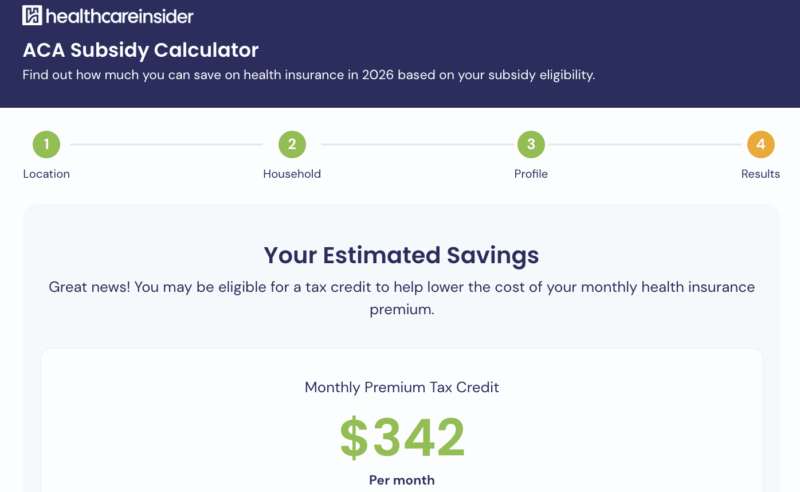Written by Michael LaPick
Healthcare Writer
We want to help you make educated healthcare decisions. While this post may have links to lead generation forms, this won’t influence our writing. We adhere to strict editorial standards to provide the most accurate and unbiased information.
Key Takeaways
- If Congress doesn’t renew enhanced ACA tax credits, older Marketplace enrollees face the biggest premium hikes.
- A 60-year-old could pay nearly $9,600 more per year for ACA coverage in 2026.
- The “subsidy cliff” returns, cutting off aid for people earning above 400% of the federal poverty level (FPL).
- Middle-income early retirees and self-employed Americans could feel the steepest impact.
- ACA Marketplace premiums may increase by a median of 18% nationally, further driving costs up.
Overview: A Looming Price Shock for Older ACA Enrollees
Imagine turning 60 and planning for early retirement only to find your health insurance premiums jump by almost $10,000 a year. That’s the reality some older adults could face if enhanced Affordable Care Act (ACA) premium tax credits expire after 2025.
According to a Kaiser Family Foundation (KFF) analysis, without Congressional action to extend these enhanced credits, older Americans who buy insurance through the ACA Marketplace could see the steepest health insurance premium increases in more than five years.
These tax credits have been a financial lifeline for middle-income individuals, especially those earning just above 400% of the federal poverty level (FPL), or about $62,600 for an individual in 2026.
What Are Enhanced ACA Premium Tax Credits?
Enhanced ACA premium tax credits were first introduced under pandemic relief legislation and extended by the Inflation Reduction Act.
They lowered the percentage of income enrollees pay toward health insurance premiums and expanded eligibility to people earning above 400% FPL — a change that allowed many middle-income Americans, especially those in their 50s and early 60s, to qualify for assistance.
If these enhancements expire after 2025, subsidy eligibility would revert to pre-pandemic rules — cutting off help for those just over the income threshold. This is commonly referred to as the “subsidy cliff.”
To see how these subsidies currently affect your premiums, try our ACA Subsidy Calculator for a personalized estimate.
Who’s at Risk: Older Adults and Middle-Income Retirees
The same KFF analysis notes that among ACA enrollees with incomes above 400% FPL, 51% are between ages 50 and 64. Many of these individuals are early retirees or self-employed, with no access to employer-sponsored coverage and not yet eligible for Medicare.
Because health insurance premiums rise with age — insurers can charge up to three times more for older adults than for younger ones under ACA’s age rating rules — this group would be hit hardest if tax credits lapse.
Example: A 60-year-old with income slightly above $62,700 (401% FPL) could see their annual premium rise from $5,328 in 2025 to $14,931 in 2026 — nearly $9,600 more out of pocket [source: KFF, 2025].
Meanwhile, a 40-year-old at the same income level would pay about $4,500 more. Younger adults (21-year-olds) would see smaller increases of roughly $838.
Our 2026 Guide to ACA Marketplace Plans can help older adults evaluate coverage options and prepare for possible premium changes.
The Double Whammy: Subsidy Cliff + Premium Inflation
If enhanced ACA tax credits expire, older Marketplace enrollees face a “double whammy”:
- Loss of subsidies — cutting off assistance for those over 400% FPL.
- Rising base premiums — insurers have proposed a median premium increase of 18% for 2026.
These two forces combined could lead to the highest out-of-pocket costs since the ACA launched in 2014.
| Age | 2025 (with Enhanced Credits) | 2026 (without Credits, +18%) | Annual Increase |
|---|---|---|---|
| 21 | $4,656 | $5,496 | +$840 |
| 40 | $5,328 | $7,020 | +$1,692 |
| 50 | $5,328 | $9,828 | +$4,500 |
| 60 | $5,328 | $14,931 | +$9,603 |
| 64 | $5,328 | $16,500 | +$11,172 |
Source: KFF analysis of Healthcare.gov and state-based exchange data (2025–2026).
How the Subsidy Cliff Creates Inequity
The subsidy cliff means that two people with nearly identical incomes could pay drastically different premiums — simply because one earns slightly above the cutoff.
For example, a 64-year-old earning $62,600 (400% FPL) in 2026 would still qualify for premium tax credits, while someone earning $62,700 (401% FPL) would not. That $100 difference in income could translate to over $11,000 in additional annual premium costs.
This inequity hits middle-income Americans hardest, people who don’t qualify for Medicaid or employer coverage, but who also don’t earn enough to comfortably absorb large premium increases.
Policy Outlook: Will Congress Act?
Congress could extend the enhanced ACA premium tax credits beyond 2025, but as of late 2025, the future remains uncertain. The credits have been politically popular, yet their extension carries a significant federal cost.
If no action is taken, premium notices for 2026 plans could reflect the full impact of both the subsidy cutoff and insurer rate increases. Consumers shopping on Healthcare.gov may face sticker shock — particularly older Marketplace enrollees and early retirees.
What You Can Do Now
If you’re approaching your 60s or considering early retirement, here are steps to prepare:
- Estimate your 2026 income carefully — even small differences can affect subsidy eligibility.
- Compare ACA Marketplace options early in open enrollment using tools like the ACA Subsidy Calculator.
- Look into supplemental or short-term medical coverage if you anticipate income fluctuations.
- Explore recommended health Insurance options for early retirees to find coverage that fits your transition before Medicare.
- Consult a licensed insurance agent or compare plan options online.
A friendly team of licensed insurance agents is here to guide you.
Bottom Line: Planning for Possible Premium Changes
If Congress doesn’t renew the enhanced ACA tax credits, older adults may see some of the largest premium increases in Marketplace history.
A 60-year-old earning $62,700 could pay nearly $10,000 more in 2026, and those just over the subsidy cliff would shoulder the biggest financial burden.
The good news? You can prepare by staying informed and comparing plans annually.
Health insurance is a major financial decision, and small policy changes can make a big difference in what you pay.
Thank you for your feedback!







